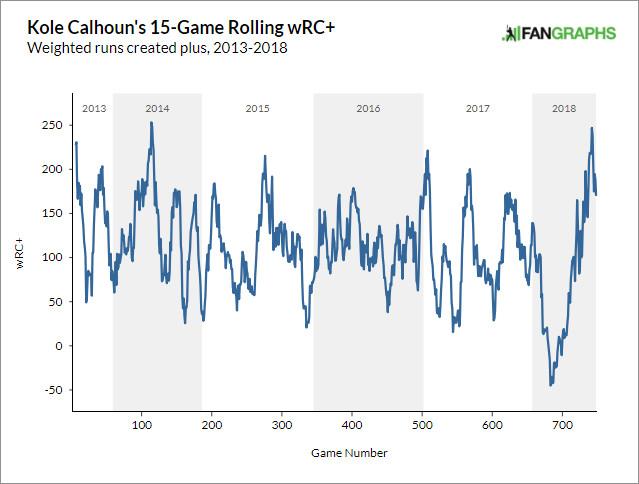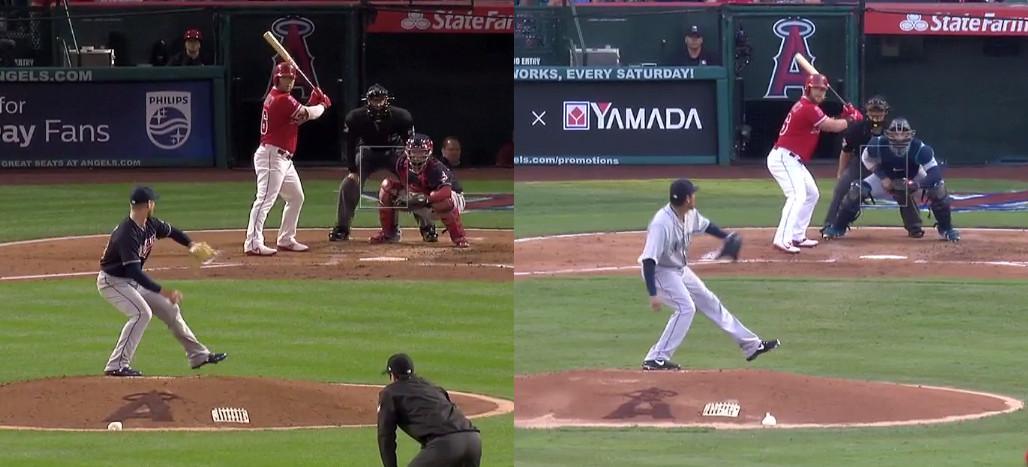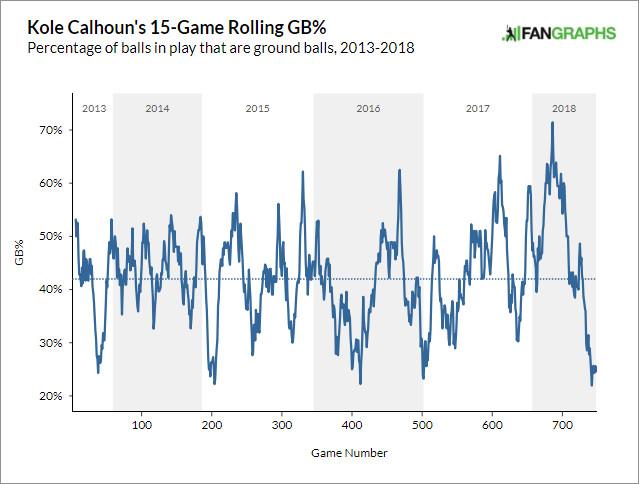
In the seventh inning of a game against the Tigers on May 31, Angels right fielder Kole Calhoun stepped to the plate to face Detroit reliever Louis Coleman with little at stake other than self-esteem. The Angels, trailing 6–1 with one out and no one on, had just a 2.5 percent chance to win the game, and there was little reason for anyone in the Comerica Park crowd to stress over the at-bat. But there was every reason for Calhoun to be antsy, because no big league batter needed a hit — or for that matter, any non-out — more than he did.
Calhoun, who was 0-for-2 to that point in the game, swung through a 90 mph fastball for strike one and fouled off another at 91 mph for strike two. Then he chased a low slider for strike three, succumbing to Coleman despite having the platoon advantage against the righty reliever.
That strikeout sank Calhoun’s seasonal line to .145/.195/.179 in 185 plate appearances, including seven double plays. When Calhoun’s spot in the order — eighth — came up again in the game, Angels manager Mike Scioscia pinch hit for him. The next day, he didn’t start. And the day after that, the Angels placed him on the 10-day DL with a right oblique strain. Injury had been added to insult, seemingly compounding a disastrous start to the season. Yet in Calhoun’s case, the timeout marked the beginning of better days.
“No one ever wants to go on the DL,” Calhoun said this month via phone. “But looking back now, at least for this season — maybe even for my career — it’s probably the best thing that’s ever happened to me.”
When he hit the DL, Calhoun was weighed down by a .374 OPS that dragged behind him, clanking and chafing like Jacob Marley’s chains. Think of another hitter who had a rough start to the season. Maybe you’re imagining the Rangers’ Rougned Odor: His OPS through May was 179 points higher than Calhoun’s. The Orioles’ Chris Davis? 109 points higher than Calhoun’s. The Astros’ Jake Marisnick, who slumped so severely that Houston optioned him to Triple-A in mid-May? 86 points higher than Calhoun’s. Of the 291 hitters with at least 100 plate appearances through May 31, Calhoun’s OPS was the worst by 78 points.
This was weird. According to FanGraphs WAR, Calhoun had been an above-average player in each of his five seasons as a regular (excepting 2012, when he made his major league debut and appeared in only 21 games). He’d been an above-average batter in four of those seasons, falling short only last year, when he dipped slightly below the league baseline with a 98 wRC+. Even then, he’d finished strong, posting a 111 wRC+ in the second half, and he’d recorded an .873 OPS in spring training this year. At 30, he was likely too young to have suffered a precipitous decline in his physical skills. Yet while he continued to add value in the outfield, where Statcast appraises the former Gold Glover’s 2018 fly-catching performance as two outs above average and other systems rate his arm among the most valuable in baseball, he’d completely cratered at the plate.
“This offseason I tried to do some things with my swing and improve,” said Calhoun, who explained that he wasn’t specifically trying to raise his launch angle but was aiming to get the ball off the ground. “The way I was trying to do it wasn’t the correct way,” he adds. “I don’t know how to explain it. I don’t really know that I knew what I was doing.”
Calhoun’s winter tinkering got him into bad habits that produced the opposite of his intended result. “I was not really getting off my backside and [was] getting stuck behind me, which made my swing path really shallow in the zone and resulted in some weak fly balls to left field and balls on the ground to the right side,” he said. Through May, 56 percent of Calhoun’s batted balls had been on the ground, which was bad both because it translated to less power and because Calhoun, who’s not blessed with the speed to beat out hits and tends to pull his grounders more often than average, is easy to defend against. “Any balls on the ground in the big leagues these days are not really great, honestly, with all the shifts that everybody’s putting on,” said Calhoun, who’s faced an infield shift on 68.7 percent of the pitches he’s seen this season, the 15th-highest rate among the more than 300 hitters who’ve faced at least 500 pitches.
As one might imagine, it’s no fun to be in baseball’s worst slump. “Being a competitor, you tell yourself, ‘Today’s the day. Today’s the day,’” Calhoun said. “But it was a struggle, for sure. A struggle mentally. A struggle physically — just not being able to feel like myself.”
With some statistical perspective, Calhoun’s season-starting slump looks even more extreme. Baseball Prospectus publishes a metric called RPA+, which measures the runs per plate appearance that a hitter produces, measured against the league average. It’s expressed on the same scale as OPS+ or wRC+, where 100 is average and lower is worse. Calhoun’s RPA+ through May was -9, which was the worst of any hitter with a minimum of 150 plate appearances through May since at least 1950, the first year for which RPA+ data is available. In other words, no other regular hitter on record has started a season as cold as Calhoun.
Lowest RPA+ Through May (Min. 150 PA)
Calhoun said the oblique injury was a product of his desperation to escape the slump. “I had been swinging like crazy just because I was trying to find something that would help me get out of the funk that I was in,” he said. He felt a twinge in his oblique at the end of May and talked to the Angels’ trainers, who told him that short-term time off might save him from aggravating the injury and missing more time later in the season. Had he been hitting, the temptation to try to play through the injury might have been stronger, but given where his stats stood, Calhoun said that he “decided it probably would be best for me, health-wise — and probably even from a mentality standpoint — to go on the DL.”
Calhoun returned from the mental/oblique break on June 18 and, batting ninth, went 2-for-3, giving him only his third multihit game since April 11. The next day, he hit a home run — his first homer and second extra-base hit since Opening Day, when he’d batted fifth. The game after that, he homered again. Suddenly, Calhoun was hot. And in July, he got hotter, hitting .322/.378/.759 with a league-leading 10 home runs, which tied him with José Ramírez for the most blistering performance of the month among qualified American Leaguers. Here’s what Calhoun’s wild ride this season looks like in graphical form:

In the span of a few months, Calhoun went from being colder than he’d ever been to about as hot as he’d ever been. “It’s definitely pretty extreme,” Calhoun said. “I don’t know if I’ve ever really experienced anything like it.” Almost no hitter ever has. Baseball Prospectus provided The Ringer with RPA+ data for all hitters in all calendar months going back to 1950 in which they recorded at least 80 plate appearances. Only one hitter — the Dodgers’ Ron Fairly in 1966 — has ever experienced a more drastic difference between his best and worst offensive months in a single season than Calhoun has in 2018.
Biggest Differences Between Best and Worst Months
The down-and-up trajectory of Calhoun’s season is almost enough to make one believe in the gambler’s fallacy, but it’s neither a cosmic kindness nor a coincidence that he’s found his stroke. In addition to whatever benefits the two-and-a-half-week breather may have had for his brain, Calhoun also reset his stance and his swing, fixing flaws that would have been difficult to diagnose and address without the time away. He didn’t do it by himself: While he was rehabbing in Arizona, he worked closely with two former big leaguers who’ve since become minor league coaches, Angels hitting coordinator Jeremy Reed and assistant hitting coordinator Shawn Wooten, whom Calhoun said “really, really helped me understand what my problems were … and show[ed] me some video and just ask[ed] me if I was open to hearing what they had to say. Obviously, I said, ‘Yeah.’” When a hitter’s OPS is under .400, he’ll say yes to almost anything.
Calhoun said that Wooten and Reed showed him some postures that he’d had success with in years past at the plate, but that he wasn’t using this year. “I was way more straight up and taller earlier in the season,” he said. “And now you see my spine’s just trying to stay over the ball a little bit more. … In the past, I was getting to the spot that I’m starting at now. It looks like I’m in a crouch, but I’m literally trying to just keep my body in a powerful position.” Once Calhoun’s side healed enough for him to start swinging, he put the new positioning into practice. The change in his stance is obvious in a side-by-side view of his setups from April (left) and July (right).

“My biggest problem was I was getting stuck on my backside,” Calhoun continued, adding, “I wasn’t really rotating all the way and had my back hip sucked under me, and now it’s actually moving into the ball.” The GIFs below show the difference in his swings from the side. Here’s an April single…
…and a July double.
Right away, that freedom of movement started yielding much more power — in a five-game rehab assignment in Triple-A, Calhoun slashed .316/.350/.632. It’s also led to many more fly balls: As the chart below shows, Calhoun’s ground-ball rate in the big leagues has gone from its highest level ever before the DL break to its lowest level ever thereafter.

Prior to breaking down and being built back up again, Calhoun confessed, he “never really had the checkpoints to go back” when something mechanical was amiss. But now, he said, “I feel like I have a better understanding of the things that got me in trouble and the things that I want to try to avoid.” In that sense, the deep slump may pay dividends in the long run. By studying himself, he’s established benchmarks and baselines that he’ll be able to revert to when he hits the next rough patch, theoretically shortening the time that it takes him to come out of it. To that end, Calhoun has made monitoring his setup via video review a more regular part of his routine.
When Calhoun came off the DL, the hill ahead of him was so steep that he resolved not to focus on inflating his full-season stats. “I can’t do anything about it,” he said. “What happened before is in the past, and the numbers are whatever they are. And once I came back I told myself I’m not even gonna really worry about that. I’m trusting what I’m doing now.” When a player reaches mid-June with an OPS under .400, he can be forgiven for saying, as Calhoun does, that he’s “taking it day by day.” In his case, that isn’t so much a cliché as it is a self-preservation strategy.
The silver lining to Calhoun’s historically slow start is that he has a chance to record a historic recovery from a slow start. The list below shows the largest post-May improvements in RPA+ since 1950, with a minimum of 150 plate appearances both through and after the end of May. For now, Calhoun’s recent tear—not even including his 2-for-4 performance with yet another homer on Wednesday—has put him atop the table.
Biggest Post-May Offensive Improvements
Now that the dark days are behind him, Calhoun is able to laugh about his slump. “I guess you could say I wasn’t seeing [the ball] well,” he said with a snort. Belatedly contributing to the Angels — who gave him a longer leash than many contending teams would have allowed a sub-star-level player — has, he said, “made it a little easier to sleep at night.” Calhoun is now batting at or near the top of the team’s order, and his full-season OPS (.669) is nearing respectability. If his hot hitting continues, he could achieve an outcome that would have been almost unimaginable in May: ending the summer with a stat line that, on the surface, won’t look like it came from an anomalous season at all.
All stats updated through Tuesday’s games. Thanks to Rob McQuown of Baseball Prospectus and Jeff Zimmerman of FanGraphs for research assistance.

